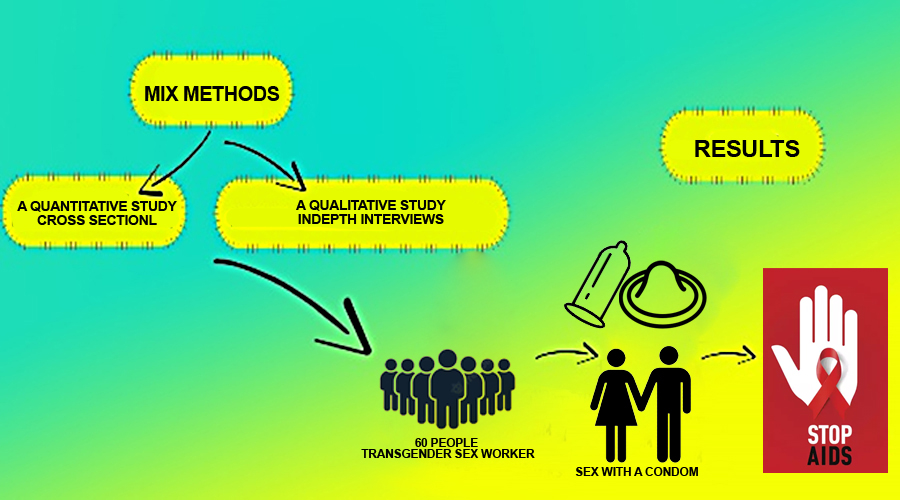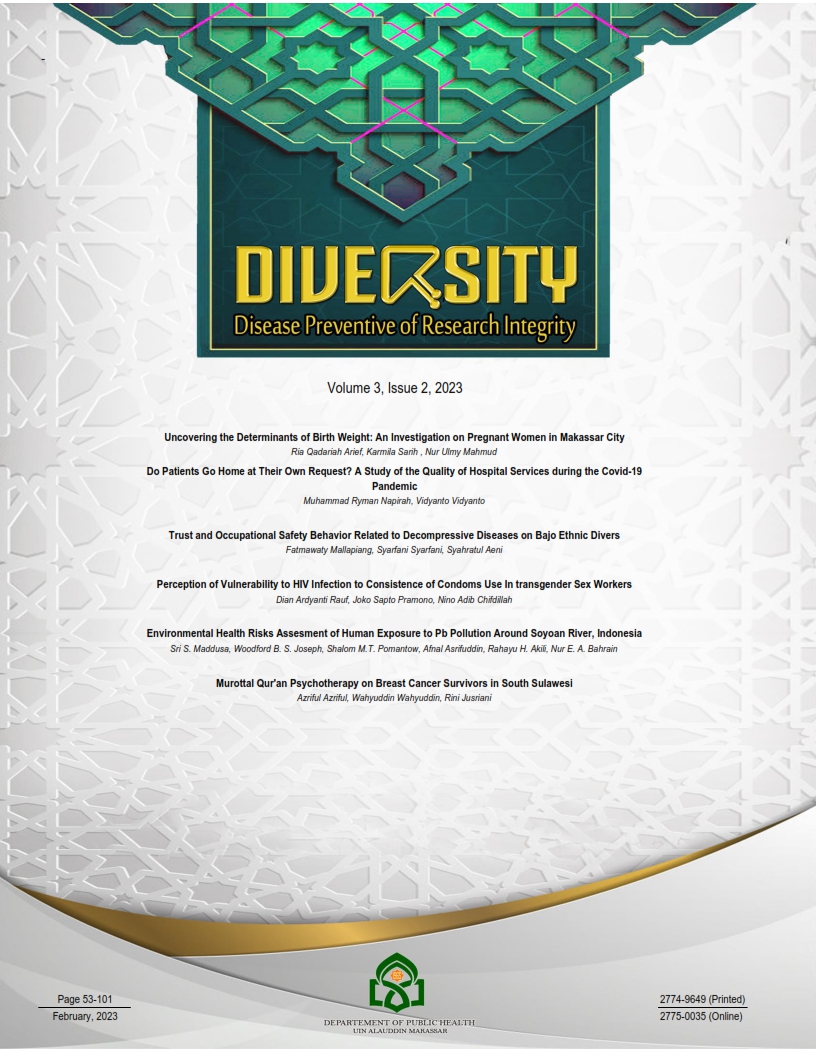Perception of Vulnerability to HIV Infection to Consistence of Condoms Use In transgender Sex Workers
Abstract
Transgender is a group with a high risk of HIV AIDS transmission due to the large number of base areas for transgender to conduct sexual transactions with sex partners. Changing behavior among transgender sex workers is still complicated because of the low use of condoms among transgender women. The study aimed to analyze the relationship between perceptions of vulnerability to contracting HIV with the consistency of using condoms among transgender sex workers to prevent HIV AIDS in the city of Makassar. This type of research was mixed methods research with a quantitative and qualitative approach using a sequential explanatory design (combination model). The quantitative data collection technique used a cross-sectional research design. The qualitative data used in-depth interviews with a research design using case studies to strengthen the quantitative results obtained from HIV-positive transgender sex workers. The number of respondents in this study was 60 people. The results showed a relationship between perceived vulnerability to contracting HIV and the consistency of condom use among transgender sex workers. Islam explicitly states that homosexual and lesbian behavior is a form of deviant sexual behavior contrary to human nature. Sex in Islam is not just to satisfy lust but has an important goal regarding the continuity of life, namely continuing offspring/ reproduction so that same-sex relations are unlikely to produce offspring, so this is not in line with the purpose of sex in Islam.

Downloads
References
Bass, S. B., Kelly, P. J., Brajuha, J., Gutierrez-Mock, L., Koester, K., D’Avanzo, P., & Sevelius, J. (2022). Exploring barriers and facilitators to PrEP use among transgender women in two urban areas: implications for messaging and communication. BMC public health, 22(1), 1-10. https://doi.org/10.1186/s12889-021-12425-w
Budhwani, H., Turan, B., Hasbun, J., Rosario, S., Tillotson, L., McGlaughlin, E., & Waters, J. (2017). Association between violence exposure and condom non-use among transgender sex workers in the Dominican Republic: the mediating role of trust. International journal of STD & AIDS, 28(6), 608-612. https://doi.org/10.1177/0956462416659421
Budiman, N. A., Istiarti, T., & Syamsulhuda, B. M. (2008). Faktor-faktor yang berhubungan dengan praktik wanita pekerja seks (WPS) jalanan dalam upaya pencegahan IMS dan HIV/AIDS di sekitar alun-alun dan Candi Prambanan Kabupaten Klaten. Jurnal Promosi Kesehatan Indonesia, 3(2), 120-126. https://doi.org/10.14710/jpki.3.2.120-126
Castelli, F., & Sulis, G. (2017). Migration and infectious diseases. Clinical Microbiology and Infection, 23(5), 283-289. https://doi.org/10.1016/j.cmi.2017.03.012
Chanakira, E., O’Cathain, A., Goyder, E. C., & Freeman, J. V. (2014). Factors perceived to influence risky sexual behaviours among university students in the United Kingdom: a qualitative telephone interview study. BMC public health, 14(1), 1-7. https://doi.org/10.1186/1471-2458-14-1055
Deeks, S. G., Overbaugh, J., Phillips, A., & Buchbinder, S. (2015). HIV infection. Nature reviews Disease primers, 1(1), 1-22. https://doi.org/10.1038/nrdp.2015.35
Demartoto, A. (2011). Perilaku Seksual MSM (Men Who Have Sex With Men) dalam kaitannya dengan HIV AIDS. Lemb Swadaya Masy Gessang.
Desai, M., Goel, S., Desai, M., & Goel, S. (2018). Adolescent Rights to Prevention of Problems with Sexual Relationships. Child Rights Education for Inclusion and Protection: Primary Prevention, 265-297. https://doi.org/10.1007/978-981-13-0417-0_9
Dinas Kesehatan Kota Makassar. (2017). Profil Kesehatan Kota Makassar. Dinas Kesehatan Kota Makassar. Makassar.
Duarte, R., Lönnroth, K., Carvalho, C., Lima, F., Carvalho, A. C. C., Muñoz-Torrico, M., & Centis, R. (2018). Tuberculosis, social determinants and co-morbidities (including HIV). Pulmonology, 24(2), 115-119. https://doi.org/10.1016/j.rppnen.2017.11.003
Eda, N. (2012). Niat Penggunaan Kondom pada Komunitas Waria di Kota Ternate. Jurnal Promosi Kesehatan Indonesia, 7(2), 174-183. https://doi.org/10.14710/jpki.7.2.174-183
Enggarwati, I., H. (2016). Faktor-Faktor yang Berhubungan dengan Perilaku Pencegahan Penularan HIV/AIDS pada Waria Pekerja Seks Di Kabupaten Kudus Tahun 2015 ( Studi Kasus Waria Pekerja Seks di Wilayah Kabupaten Kudus ). Under Graduates thesis, Universitas Negeri Semarang. http://lib.unnes.ac.id/23337/
Folayan, M. O., Odetoyinbo, M., Brown, B., & Harrison, A. (2014). Differences in sexual behaviour and sexual practices of adolescents in Nigeria based on sex and self-reported HIV status. Reproductive Health, 11(1), 1-12. https://doi.org/10.1186/1742-4755-11-83
Ginting, D. (2019). Hubungan konsistensi pemakaian kondom dengan kejadian Infeksi Menular Seksual (IMS) pada wanita pekerja seks di Tanjung Morawa. Majalah Kedokteran Nusantara: The Journal of Medical School, 52(1), 9-16. https://talenta.usu.ac.id/tjms/article/view/3655
Irianto, K. (2014). Epidemiologi Penyakit Menular dan Tidak Menular. Bandung: Alfabeta.
Khairani, A., & Saefudin, D. (2018). Homoseksual Berdasarkan Pandangan Psikologi Islam. Ta'dibuna: Jurnal Pendidikan Islam, 7(2), 114-136. http://www.doi.org/10.32832/tadibuna.v7i2.1356
Koeswinarno. (2004). Hidup sebagai Waria. Huda NS, editor. Yogyakarta: PT. LKis Yogyakarta.
Nurdiyanah, N., Azriful, A., & Rauf, D. A. (2015). Perilaku Berisiko terhadap Pasangan Lesbian di Kota Makassar (Studi Kasus). Al-Sihah: The Public Health Science Journal. https://doi.org/10.24252/as.v7i2.1990
Ochoa, S. C., & Sampalis, J. (2014). Risk perception and vulnerability to STIs and HIV/AIDS among immigrant Latin-American women in Canada. Culture, health & sexuality, 16(4), 412-425. https://doi.org/10.1080/13691058.2014.884632
Priyoto. (2014). Teori Sikap dan Perilaku dalam Kesehatan. Yogyakarta: Nuha Medika. 138-139 p.
Rodger, A. J., Cambiano, V., Bruun, T., Vernazza, P., Collins, S., Van Lunzen, J., & PARTNER Study Group. (2016). Sexual activity without condoms and risk of HIV transmission in serodifferent couples when the HIV-positive partner is using suppressive antiretroviral therapy. Jama, 316(2), 171-181. https://doi.org/10.1001/jama.2016.5148
UNAIDS. (2016). Guidelines for second generation HIV Survailance. UNAIDS/ WHO.
Villar, C. C., & Dongari‐Bagtzoglou, A. (2021). Fungal diseases: Oral dysbiosis in susceptible hosts. Periodontology 2000, 87(1), 166-180. https://doi.org/10.1111/prd.12378
Waldorf, K. M. A., & McAdams, R. M. (2013). Influence of infection during pregnancy on fetal development. Reproduction (Cambridge, England), 146(5), R151. https://doi.org/10.1530%2FREP-13-0232
Weil, D. N. (2014). Health and economic growth. In Handbook of economic growth (Vol. 2, pp. 623-682). Elsevier. https://doi.org/10.1016/B978-0-444-53540-5.00003-3
Widoyono. (2011). Penyakit Tropis. Epidemiologi, Penularan, Pencegahan, dan Pemberantasannya. In: edisi revisi II. Jakarta: Erlangga Medical Series.
YPKDS (2017). Surveilans KPAP Sulawesi Selatan.
Zaini, H. (2017). LGBT dalam perspektif hukum islam. JURIS (Jurnal Ilmiah Syariah), 15(1), 65-74. http://dx.doi.org/10.31958/juris.v15i1.489
Copyright (c) 2023 Dian Ardyanti Rauf, Joko Sapto Pramono, Nino Adib Chifdillah

This work is licensed under a Creative Commons Attribution-NonCommercial-ShareAlike 4.0 International License.
Authors retain copyright and grant the journal right of first publication with the work simultaneously licensed under a Creative Commons Attribution-NonCommercial-ShareAlike 4.0 International License that allows others to share the work with an acknowledgment of the work's authorship and initial publication in this journal.
Authors are able to enter into separate, additional contractual arrangements for the non-exclusive distribution of the journal's published version of the work (e.g., post it to an institutional repository or publish it in a book), with an acknowledgment of its initial publication in this journal.
Authors are permitted to publish their work online in third parties as it can lead to wider dissemination of the work.




